Searching for mud snakes.
Mud-covered men were fishing in the ditch, and gasoline fumes and the roar of an outboard motor filled the humid air. This seemed out of place in the peaceful mosaic of bright green grass and water that extended to the horizon. The landscape was full of small, man-made ditches dug into the banks of streams and canals. Each ditch had an owner, and members of the community would trade, sell and lease them. We termed the ditches "fish bays."
During several weeks of exposure to open water, the fish bays would be colonized by local fauna. Fishermen would then separate the bays from the open water of the stream or canal using a wall of boards and mud. They would then drain the fish bays and collect the stranded fish (including gouramis, snakeheads, catfish and other species). Once the fish were removed, the blocking wall was removed, water rushed back into the fish bays, and new fauna would begin colonizing them again.
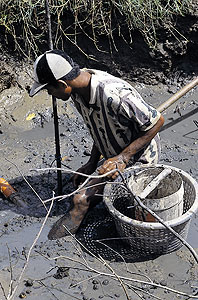
Photo Credit: John C. Murphy
Ban Tha Hin fishermen catch fish by draining “fish bays,” which are man-made ditches located alongside streams and canals. Snakes are found in these, as well.
Gathering fish in this manner was routine in Ban Tha Hin, a small village in southern Thailand. And for us, for several weeks each summer from 1996 to 1999, it was a valuable source of aquatic snakes.
Ban Tha Hin is located on the eastern shore of Lake Songkhla, a 247,000-acre wetland comprised of three shallow basins. The lake is mostly freshwater and home to a unique community of freshwater and marine fauna. Seahorses, pipefish and true sea snakes live alongside freshwater fish and snakes in this inland sea.
During a preliminary visit to Ban Tha Hin and the surrounding area we found five major lineages of snakes represented by aquatic species. One of these species became our primary focus: the rainbow water snake (Enhydris enhydris).
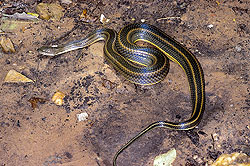
Photo Credit: John C. Murphy
The rainbow water snake (Enhydris enhydris) became a main target of the authors’ research..
Homalopsine Snakes
Homalopsine snakes — the Oriental-Australian rear-fanged water snakes — inhabit a variety of freshwater and marine habitats from the Indus River Valley in Pakistan eastward into India and Nepal, across Myanmar (Burma) and into the Indochinese Peninsula, and northward into southern China. They extend southward into the islands of Indonesia and eastward to the Philippines, New Guinea and northern Australia. One species reaches the Palau Islands in Micronesia.
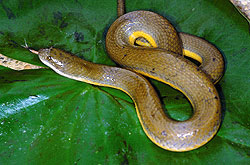
Photo Credit: John C. Murphy
Enhydris plumbea is a more terrestrial relative of E. enhydris. Only a few specimens were captured in Ban Tha Hin, but it was plentiful in Kayumadang, an agricultural area.
.
Homalospine snakes are usually considered a subfamily, the Homalopsinae, of the family Colubridae. All of them have valvular nostrils combined with a mechanism for complete mouth closure, and a trachea that can extend to the internal nostrils within the mouth, all of which facilitate their underwater lifestyle. Most also have small eyes located close to the top of the head, enlarged rear maxillary teeth that are grooved and other anatomical characteristics that suggest they all share a common ancestor. Our work on homalopsine DNA also supports the idea of a shared common ancestry.
While we don’t have reproductive data on all species, it seems probable that all give birth to live young, which are nourished during development through a placenta via the female’s circulatory system.
Hidden Rainbows
Ban Tha Hin rainbow water snakes were captured using funnel traps baited with pieces of fresh fish. (Funnel traps are screen cylinders with a plastic funnel attached to one end; the opposite end is folded and clamped.)
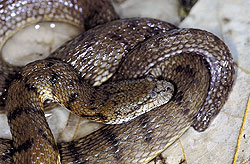
Photo Credit: John C. Murphy
Cerberus rynchops will attempt to evade capture by diving into liquid mud and surfacing elsewhere.
Traps placed at the aquatic-terrestrial edge caught more snakes than those placed in open water or open grassy areas. Enhydris enhydris uses the mud-root tangle at the water’s edge; radiotelemetry work showed it would sometimes enter open water, but it usually patrolled the shoreline in search of food or mates.
In 1997, we trapped 235 individual snakes and marked them with PIT (passive integrated transistor) tags. These were injected under the skin and could be read using a bar code reader. Early each morning, hired locals removed snakes from the traps and placed them in plastic bags labeled with the trap number. We then checked the snakes for tags, recorded length, weight and sex data, and then returned each snake to the vicinity of the trap where it had been caught.
That year we recorded 144 recaptures, and using the data estimated that the study area contained 406 to 567 rainbow water snakes. We estimated a density of one snake for about every 6 feet of shoreline.
A casual visitor to Ban Tha Hin would have little reason to suspect high densities of snakes based upon visual evidence. Only once did we ever see a snake actually surface. The dense emergent grasses, murky water and their use of the mud-root tangle hid rainbow water snakes from view.
Natural Disaster
Some disturbing messages from Vachira Lheknim, an ichthyologist at Prince of Songkhla University and one of our hosts in Thailand, preceded our visit to Ban Tha Hin in 1998. The November to February northeast monsoon annually recharges Lake Songkhla with freshwater. This year, however, there was an El Niño event. The northeast monsoon failed, and there was no water to recharge the lake. As the water level dropped, saltwater from the Gulf of Thailand intruded into the lake, and within a few days the salt concentration rose dramatically.
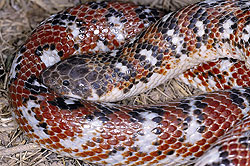
Photo Credit: John C. Murphy
Fordonia leucobalia is one of the few snakes that eats crabs.
Snails, fish and snakes died off in large numbers. When we arrived in June, snake carcasses and snail shells littered the study site, and two weeks of trapping on the same study site used so successfully the previous year produced only five rainbow water snakes. More specimens were observed when the fish bays were drained, but there was little doubt that Enhydris enhydris was not salt-tolerant. The opportunity presented to us was unprecedented — we could now document the impact of a cyclic meteorological event on an aquatic reptile population.
Before our return in 1999, Vachira informed us that the lake ecosystem was recovering, with fish and snake populations on the increase. Large patches of barren soil and yellow grass were still evident upon our arrival. Lying on the road were two freshly killed rainbow water snakes, probably discarded by fishermen as they cleaned out a fish bay. Within a few days our traps were again deployed and we began catching snakes immediately. Two weeks of trapping and 188 snakes later, we realized Vachira was correct: The snake population was rebounding quickly after the salt intrusion.
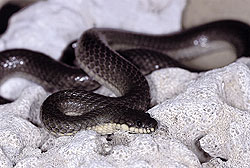
Photo Credit: John C. Murphy
Gerarda prevostiana exhibits a very unsnakelike feeding behavior: It tears crabs apart and then eats the chunks. This is the only snake known to break prey into pieces before eating it.
Enhydris enhydris has a more terrestrial relative: E. plumbea. We found a few specimens in our traps at Ban Tha Hin, but in the agricultural area known as Kayumadang (in Sabah Malaysia, an island of Borneo) it was abundant. In 1993, we trapped 185, and the following year we trapped 90. It also used the mud-root tangle below the surface at the edge of water buffalo wallows, paddy, pond and stream habitats (most were found around the wallows).
Cerebrus Species
Cerebrus species are well-known marine-estuarine snakes that frequently associate with mangroves, but they also enter freshwater as they follow streams inland. Distribution spans from India’s west coast to the Philippine and Palau Islands. There are three recognized species. The very common Cerebrus rynchops is the best known. In Lake Buhi, on the island of Luzon in the Philippines, C. microlepis is distinguished from C. rynchops by scale count differences. Also, adult male C. microlepis develop distinct tubercles over much of their heads (we don’t know if this is a mating season phenomenon or if they develop these wartlike structures as permanent parts of their anatomy). The third species, C. australis, is Australian.
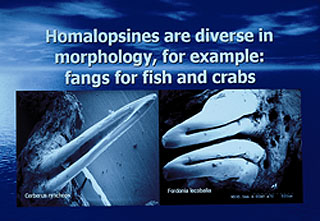
Photo Credit: John C. Murphy
These SEM (scanning electron microscope) images depict the rear fangs of the fish-eating Cerberus rynchops (left) and the crab-eating Fordonia leucobalia (right)..
One of us (HKV), along with Bruce Jayne of the University of Cincinnati and Kiew Bong Heang of the University of Malaysia, studied C. rynchops at Muar, Malaysia, in a Straits of Malacca estuary from 1984 to 1986. Most specimens were collected on mud flats, and mudskippers made up a large portion of the snakes’ diet. A mark-release-recapture study was done, and the population was estimated between 374 and 1,396 snakes.
Like other homalopsines, Cerebrus are closely associated with muddy substrates. Cerebrus rynchops does not hesitate to escape capture by diving into liquid mud and surfacing several feet away. Local fishermen at a remote village on Thailand’s Pak Phang Peninsula were familiar with C. rhynchops. We asked them if the snakes eat crabs. They smiled and said no, the crabs eat the snakes. We offered a reward for a few specimens, and upon our return the following morning they had several burlap bags filled with more than 40 snakes that were collected by one man in two hours. Here was another location with a dense homalopsine population.
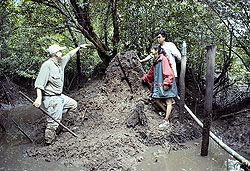
Photo Credit: John C. Murphy
Estuarine homalopsines and mud lobsters frequent the same habitat, and snakes have been found in mud lobster mounds such as the one pictured here.
.
When we compared scale counts, the Southeast Asian Cerebrus populations and the Australian populations were virtually indistinguishable, an observation also made by Harold Cogger years ago. New evidence, however, suggests that these are indeed separate species. We recently compared mitochondrial DNA genes 12S, 16S and cytochrome b for seven populations of Cerebrus and found that C. microlepis was about 2.1 percent different from the other Southeast Asian populations, while C. australis was 6.6 percent different. This suggests that C. australis has been long isolated from its Southeast Asian relatives and gone its own way genetically, but has conserved a morphology that is well suited for life in the mangroves and mud flats of both Asia and Australia.
William and Margaret Dunson demonstrated that Cerebrus species have a salt gland, but that it was not always well developed and increased in size in response to a snake’s exposure to saltwater. Salt glands and salt tolerance have undoubtedly played a major role in allowing Cerebrus to disperse throughout Asian and northern Australian marine environments.
Salt glands are unknown in other homalopsines, but it seems likely they will be discovered in Bitia hydroides, Cantoria violacea, C. annulata, Fordonia leucobalia, Gerarda prevostiana and Enhydris bennettii. All these species seem to spend much of their lives in brackish or saltwater.
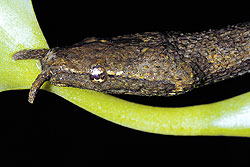
Photo Credit: John C. Murphy
The fleshy appendages on the front of Erpeton tentaculatum make this species immediately recognizable. It is unknown whether or not they provide some sort of sensory input.
.
Crustacean Ties
Relatively few snakes eat crustaceans, but it has long been known that Fordonia leucobalia eats crabs. We have, however, discovered that two other homalopsines consume crustaceans.
We collected two specimens of Cantoria violacea that contained snapping shrimp, and dissection of museum material produced more snapping shrimp. Also, based upon stomach contents of other museum material we examined, Gerarda prevostiana feeds not only on fish, but also square-backed grapsid crabs. When Bruce Jayne tried to film captive G. prevostiana feeding he had little success until he introduced a recently molted crab into the snake’s tank. Apparently, this snake specializes in crabs with soft (molted) exoskeltons, and it does something quite unexpected while eating them: Large crabs are torn apart and the pieces swallowed. To date this is the only snake known to rip large prey into chunks before swallowing them, a very unsnakelike behavior.
The first G. prevostiana specimen was described in 1837 and was from the Philippines. Later specimens came from India, Sri Lanka and Thailand, but no others were forthcoming from the Philippines until 140 years later, in the 1980s, when collectors from the University of Florida again found G. prevostiana in the Philippines. This confirmed that this is another homalopsine with a very large geographic distribution, extending from Bombay, India, to the Philippine Islands. We suspect that the reason G. prevostiana is rarely found in the Philippines is because it hides in a place no one ever looks: mud lobster mounds. Mud lobsters inhabit mangrove forests, where they burrow through the mud while consuming organic matter. What they can’t eat is piled up outside their burrows, forming cone-shaped mounds.
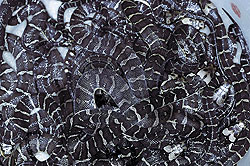
Photo Credit: John C. Murphy
A ranger at Thale Noi, the northernmost basin of the Lake Songkhla wetland complex, presented the authors with a box that contained several Erpeton tentaculatum..
We first became aware of a possible link between mud lobsters and snakes when National University of Singapore students excavated a mound and found a G. prevostiana and a Fordonia leucobalia inside. Excavation of a second mound produced another snake. Estuarine homalopsines and mud lobsters have a similar geographical distribution, and lobster mounds are built on the landward edge of the mangrove. Mudskippers, crabs and peanut worms use the outer layers of the mounds for burrows, and snapping shrimp may live in the tidal pools around the mounds. Additionally, one of the few amphibians capable of surviving saltwater, Rana crancivora, is also associated with these mounds. Thus, the burrows may provide a secure refuge for the snakes, and the commensal organisms living on and in the mound are in fact potential snake food.
Boxed Snakes
Thailand and the Indochinese Peninsula are home to about 17 species of homalopsine snakes. This area, therefore, and the Sunda Shelf to the south, appears to be the center of their distribution. Ban Tha Hin harbors Enhydris enhydris, E. plumbea and Homalopsis buccata, but other areas of Lake Songkhla hold other freshwater species.
Much of the work we did in Thailand was accomplished with the help of Tanya Cha’nard, Curator of Herpetology at the National Science Museum in Bangkok. He suggested we look at Thale Noi, the northernmost basin of Lake Songkhla’s wetland complex, for more homalopsines. One of the rangers there, Nakin Kawbonsong, was a friend of Tanya’s, and upon our arrival he had a number of specimens waiting for us.
We opened several Styrofoam boxes. Most contained Enhydris enhydris and E. plumbea, but one contained several Erpeton tentaculatus, also known as the tentacled or fishing snake, the most unique and readily recognizable serpents on the planet. Two fleshy, scale-covered protuberances extend from the front of their faces (these probably have a sensory function, but this has yet to be verified). In the water E. tentaculatus assumes a distinctive posture with its prehensile tail wrapped around submerged objects and the body extended with head and neck bent back toward the trunk. This snake is the ultimate ambush predator; it may remain motionless for hours waiting for a fish. Erpeton tentaculatus scales also support a thick growth of algae, which may attract grazing fish while at the same time camouflaging the snake.
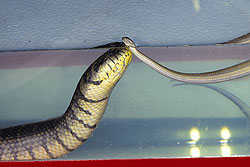
Photo Credit: John C. Murphy
The larger snake is a Bocourt’s water snake (Enhydris bocourti), one of the largest homalopsine species.
Another one of Nakin’s boxes contained a huge Bocourt’s water snake (Enhydris bocourti), the first live specimen we had seen. It was caught in a fishermen’s trap — not surprisingly, considering the Thai name for this snake is sai, meaning “fish trap snake.” This pregnant female (its girth was greater than a man’s forearm) weighed about 5 pounds and was about 40 inches long. Enhydris bocourti is most likely the largest homalopsine, although Homalopsis buccata currently holds the length record (nearly 4 feet) for the group.
Ups and Downs
Rice culture in Thailand dates to at least 5,500 years ago, and when people began flooding shallow basins to grow rice they improved the habitat for homalopsine snakes. Aquaculture is also very popular in Southeast Asia, and raising fish and shrimp in shallow man-made ponds not only improved the wetland habitat for some of these water snakes, it also increased their food supply.
As rice farming and aquaculture spread across Asia it seems likely that a positive impact resulted for the water snake population. Widespread mangrove restoration projects are underway too, which should also have a positive impact on future estuarine snake populations.
People, however, have also learned how to exploit the abundant water snakes. The snake skin industry is quite active in the Philippines, and it has used sea snake skins as well as Cerebrus skins for some time. Only recently, though, has the exploitation of water snakes in Cambodia come to light. Bryan Stuart and colleagues have recently documented what must be the largest snake harvest anywhere: In Cambodia’s Tonle Sap Lake, an estimated 8,500 snakes per day are harvested by fishermen and traded in the markets during the peak wet season (August to September). Snakes are caught in gill nets and bamboo fish traps, then sold to local crocodile farmers as crocodile food. Some of these snakes are also used for human food, particularly the rainbow snake and Bocourt’s water snake. Others are exported to China, and some skins are exported to Thailand.
At least five homalopsine species are involved in the trade, including Enhydris longicauda, which is known only from the Tonle Sap area. The Tonle Sap snake harvest is a recent phenomenon and apparently the result of overfishing the lake. Several years ago fish were caught and sold as crocodile food, but as the fish catch decreased and fish became more expensive, snakes were seen as a cheap alternative. It also seems likely that a decreased fish population also meant fewer large fish species which preyed upon small homalopsines and smaller fish. Thus, with this predator population reduced, the homalopsine and small fish populations increased.
Despite the fact that homalopsine snakes live in muddy, mosquito-filled habitats that are avoided by most people, they represent a fascinating chapter in snake evolution, and a bright rainbow in an otherwise murky, muddy ecosystem.

